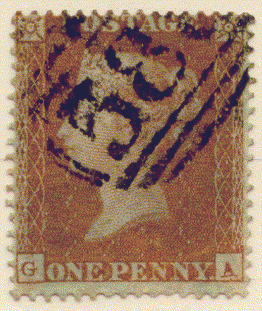
Die I, Alphabet I, Wmk S. C. , Perforated 16, Plate 100
Henry Archer's third machine was the first to be based
upon perforating, instead of rouletting. At first the results were
not favorable and required adjustments before the perforation machine was
approved. The perforated stamps that were produced by the trials
were issued for public use and can be found used in different parts of
England. many apparently went to the West of England. The experiment
was conducted from 1850 ---January 1854.
There is a desire amongst collectors to obtain covers bearing the Archer Perf 16 on cover dated before the date of the first officially perforated stamps came into use. Covers dated after 28 January 1854, although no less uncommon than the earlier covers are less popular. Stamps from Plates 90 through 101 were made available to Archer for experimentation and all were used. Traditionally, it had been believed that other plates outside of the Plate 90 -101 range were also considered to have been used by Archer, but current scholarship seems to prove otherwise. The Plates which are no longer considered part of the Archer experiment are Plates 8, 71, 79, 105 and 107. The scarcest of the Archer Perf 16 Plates, at least in the sense of catalog value is Plate 92, used on cover dated 1850-1.

Die I, Alphabet I, Wmk S. C. , Perforated 16, Plate 100
Identification of the Archer Perf 16 stamps is most easily accomplished through identification of the check letters. Archer used only Plates 90-101 which are all Alphabet I plates. The Officially perforated stamps were issued using Alphabet II. Therefore in order to be an Archer it must be Die I, Small Crown, Perforated 16, Alphabet I.